The design of Burgos Cathedral was influenced by the great French Gothic cathedrals, such as Reims Cathedral and Bourges Cathedral. The construction of the Burgos Cathedral started in 1221. In the 15th and 16th centuries, important modifications were made, including changes of the spires, the tower of the transept were built and the Chapel of the Condestable, the chapel is the most magnificent chapel of the cathedral. The Chapel of the Condestable was built in the 15th century, in the centre stands the beautiful 16th century tomb of the founders. The tomb of the Spanish hero El Cid is situated below the lantern of the transept. The Escalada Dorada is a golden staircase. The Portada del Sarmental is the south portal and the Puerta de la Coroneria is the north portal. The cathedral houses liturgical and religious art and treasures, among them the statue 'Christ Tied to the Column'. Burgos Cathedral is located in Northern Spain, on the pilgrimage route to Santiago de Compostela. The cathedral is dedicated to the Virgin Mary. Burgos Cathedral lies 20 km from the World Heritage Archaeological Site of Atapuerca and 89 km from the World Heritage San Millán Yuso and Suso Monasteries. Burgos Cathedral was declared a UNESCO World Heritage in 1984. World Heritage Art: The Condestable Chapel and The Chapel of the Condestable
www.werelderfgoedfotos.nl © Copyright World Heritage Photos
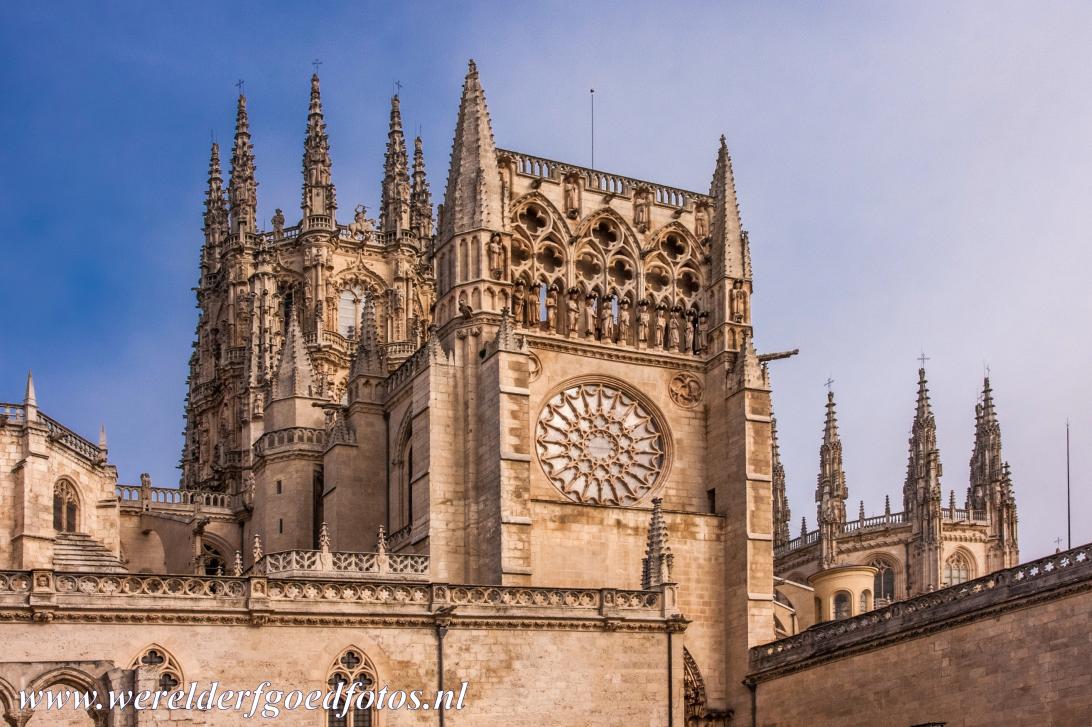
Burgos Cathedral: The 16th century octagon-shaped tower of the transept. The construction of the cathedral was begun in 1221. In the 15th and 16th centuries, important modifications were made to the cathedral, including changes of the spires and the octagonal tower of the transept was built. Burgos Cathedral was declared a UNESCO World Heritage in 1984

Burgos Cathedral: The 16th century octagon-shaped tower of the transept. The construction of the cathedral was begun in 1221. In the 15th and 16th centuries, important modifications were made to the cathedral, including changes of the spires and the octagonal tower of the transept was built. Burgos Cathedral was declared a UNESCO World Heritage in 1984
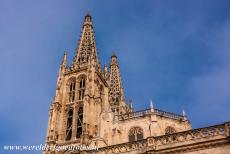
Burgos Cathedral: A spire with open stone work. The twin towers of the Burgos Cathedral were built in the 13th and 14th centuries. The design of the main façade and many other parts of the exterior were influenced by the great French Gothic cathedrals such as Reims Cathedral and the Notre Dame in Paris. The main façade gives the cathedral an imposing appearance.
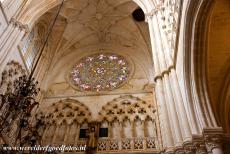
One of the rose windows of the Burgos Cathedral. The design of the interior of the cathedral was influenced by the Bourges Cathedral and Reims Cathedral in France. Burgos Cathedral is dedicated to the Virgin Mary. The official name of the cathedral is Santa Iglesia Catedral Basílica Metropolitana de Santa María de Burgos. The cathedral is situated in the Spanish city of Burgos.
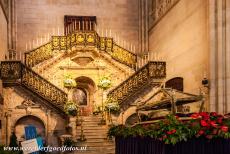
Burgos Cathedral: The Escalada Dorada, the Golden Staircase is situated in the north transept. The Golden Staircase was created in the period 1519-1522. The staircase was influenced by the Italian Renaissance style. The staircase is decorated with magnificent statuary and balustrades in gilded iron. It was modelled on the stairway of the Cortile del Belvedere in the Vatican Palace.
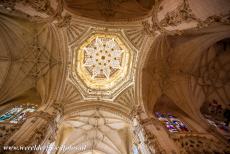
Burgos Cathedral: The lantern of the transept forms a beautiful hollow star, it was built in the 16th century. The tomb of El Cid and his wife Doña Jimena is situated below the lantern of the transept, situated between the main chapel and the choir. The main chapel has an altarpiece in the Renaissance style depicting Santa María la Mayor, the patron saint of the city of Burgos.
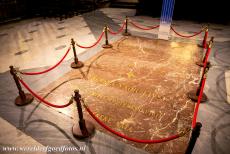
Burgos Cathedral: The tomb of El Cid Campeador, a legendary Spanish hero and icon. The tomb of El Cid, Rodrigo Díaz de Vivar, is situated below the lantern of the transept. El Cid died in 1099. He was buried in San Pedro de Cardeña. His mortal remains were moved many times. Finally in 1921, El Cid was interred in Burgos Cathedral, his final resting place.
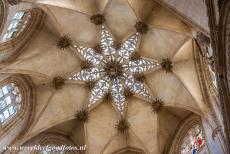
Burgos Cathedral: The star-shaped vault of the 15th century Chapel of the Condestable. In the side-naves of Burgos Cathedral are nineteen chapels, the most outstanding are the Santa Tecla Chapel and Chapel of the Condestable, built in the Flamboyant Gothic style. Burgos Cathedral was inscribed on the UNESCO World Heritage List in 1984.
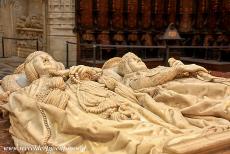
Burgos Cathedral: The Chapel of the Condestable is the most magnificent chapel of the Burgos Cathedral. The Chapel of the Condestable was built at the end of the 15th century by Simon de Cologne. In the centre of the chapel stands the magnificent 16th century white marmor tomb of the founders, Pedro Fernandez de Velasco and his wife Mencia.
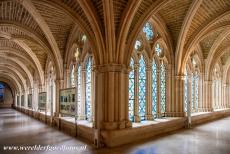
Burgos Cathedral was built of limestone, extracted from a stone quarry in the nearby village of Hontoria de la Cantera. The Lower Cloisters of Burgos Cathedral were built in the 13th century. The cathedral was built in the French Gothic style. In the 15th and 16th centuries, Renaissance elements were added. The cathedral is renowned for its vast size and unique architecture.
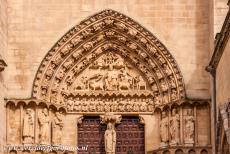
Burgos Cathedral: The Portada del Sarmental is the south portal, the portal is considered to be the most magnificent portal of the cathedral. The Portada del Sarmental was built in the period 1230 to 1240. The tympanum depicts Christ the Master, the four evangelists, the statues of the twelve apostles, the door jambs are adorned with the statues of Old Testament Kings.
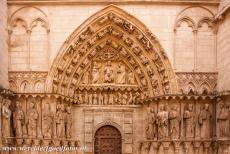
Burgos Cathedral: The Puerta de la Coroneria is the portal of the north transept. The Puerta de la Coronería, the Coronation Portal, is adorned with sculptures of the Twelve Apostles. Burgos Cathedral was a major stop for pilgrims on the way to Santiago de Compostela. Pilgrims usually enter the cathedral through the Puerta de la Coronería.
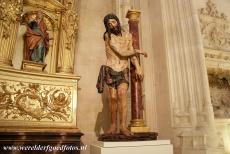
Burgos Cathedral: The Chapel of San Juan Bautista, the Chapel of St. John the Baptist, and the Chapel of Santiago houses the Burgos Cathedral Museum, the museum houses liturgical and religious art and treasures, such as gold and silver work, liturgical robes, paintings, illuminated choir books and statues, among them the 16th century statue 'Christ Tied to the Column' by Diego de Siloé.
